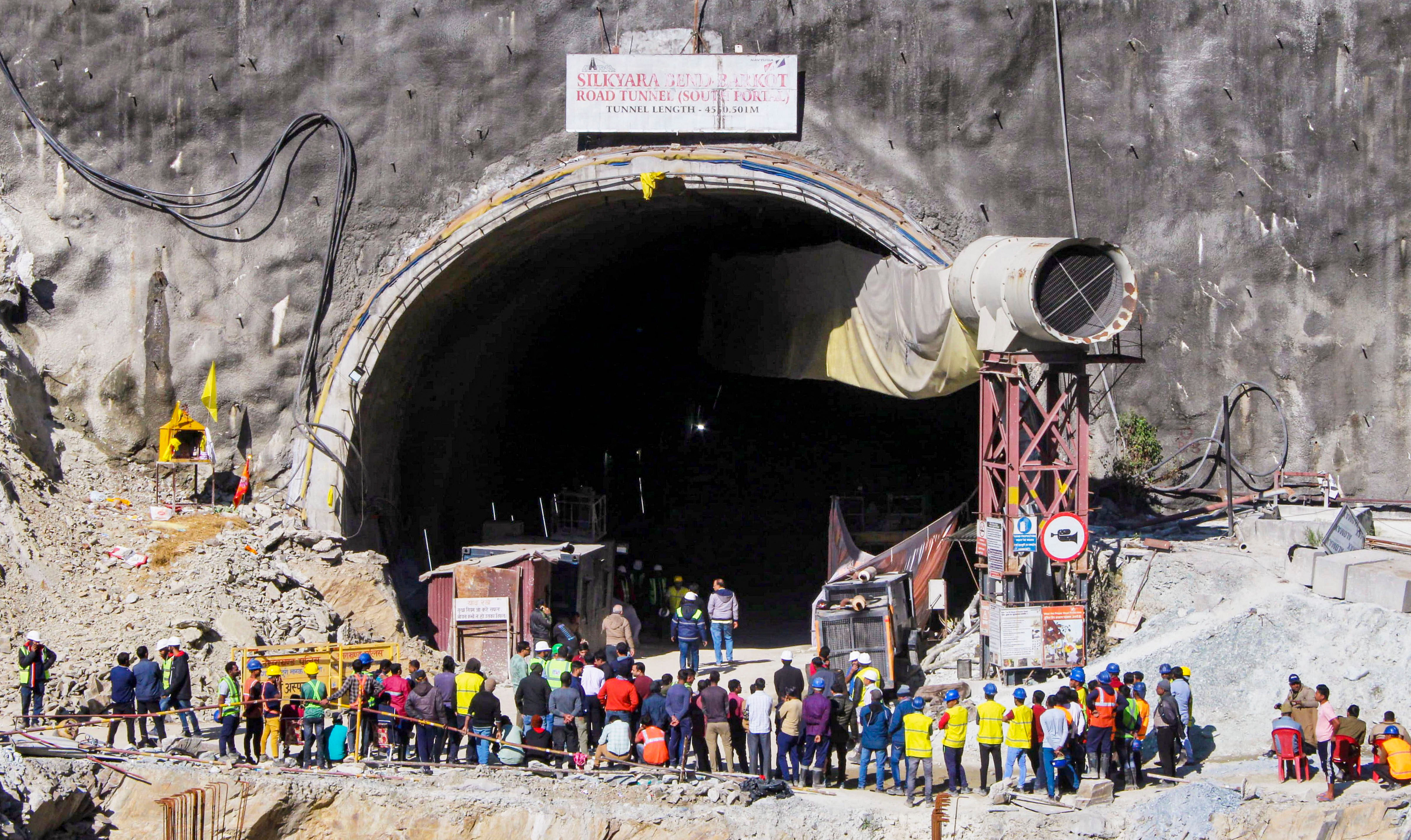
Uttarkashi: Officials at the under-construction Silkyara Bend-Barkot Tunnel after the successful evacuation of the 41 trapped workers, in Uttarkashi district.
Credit: PTI Photo
Uttarkashi remains in people’s consciousness, more so when calamities occur. The unshakeable faith of the subalterns is that the mountains protect their own, controlling everything, even those seeking shelter or inadvertantly getting trapped. Faith plays a strong role in our lives and society, and the belief that the forces of nature guide and protect our lives, even during adverse times, is very strong.
The site of the now-makeshift Baby Bhaulh Nag temple, which benignly protected 41 trapped miners for 17 long days at Silkyara in Uttarkashi, exemplifies the deep-rooted belief that mountains have fiercely protected and provided sustenance to man. Folklore tells us that the removal of the temple at the entrance of the tunnel during the construction of the Char Dham Marg led to Bhaulh Nag’s wrath, similar to the belief that the removal of Dhari Devi’s idol caused the Kedarnath floods in 2013. These temples are a part of the folk deities in the mountains, who are believed to have their abode among their devotees. The Global Climate Report, presented during the Dubai climate meet, makes a special mention of the 2021 Uttarakhand rock avalanche, which was triggered by a breach in the Nanda Devi glacier in the Himalayas. The World Meteorological Organisation (WMO) notes glaciers shrinking by 1 metre annually in a decade. Yet, how is man treating the mountains?
The ongoing Conference of Parties-28 (CoP-28) global climate discussions in Dubai have been discussing several issues that relate to climate change. Notably, on the very first day, a resolution was passed and accepted by the President of CoP-28, Sultan Al Jaber of the UAE, that a “Loan and Damage Fund” will be created to assist those countries that have suffered the aberrations of climate change. The UAE, US, UK, Japan, and the European Union have already contributed $250 million to the proposed Loss and Damage Fund, but this is grossly insufficient to reverse the damage already done or implement ameliorative measures. This fund will address the needs of affected countries in terms of climate damage as a whole. But none is talking about the outcome of the Himalayan glacier melt that has been taking place for decades, affecting the livelihood of close to a quarter of a billion people, 240 million to be precise, who depend on the glaciers and the 10 major rivers, such as the Indus, Ganga, and Brahmaputra, originating in the Himalayas. Another billion people living downstream of these rivers across eight countries, including India, are also dependent on the glacier-fed rivers. The Himalayan glaciers are melting 65% faster than the previous decade due to anthropogenic warming, potentially reducing the fresh water supply by 2 billion litres per day. This will inevitably adversely affect mountain agriculture. This author has made a detailed study of mountain agriculture, which has been published in the book Biodiversity in Agriculture, brought out by Springer Nature. Nepal will be severely affected, as will parts of India in the Himalayan region. And these regions need urgent help. Nearly a third of Nepal’s ice has disappeared during the last three decades, and it is directly linked to greenhouse gas emissions, which heat up the planet. The developed countries must clarify the delivery of US$100 billion and produce a plan to double adaptation finance to at least US$40 billion by 2025, according to Antonio Guterres, Secretary General of the United Nations. “But those sums are dwarfed by the scale of what’s needed,” he added, and he advocated reform in International Financial Institutions (IFIs) and Multilateral Development Banks (MDBs) to better cater to the needs of developing countries like Nepal.
“So, we need the outcome of this COP to call for reform of the IFIs so that they reflect today’s world and are far more responsive to the needs of developing countries and for reform of the business models of the MDBs so that they can leverage far more private finance at reasonable cost to the developing countries,” Guterres added.
Unless there is a change in course, a catastrophe can be unleashed. The glaciers could disappear altogether. That means massively reduced flows for major Himalayan rivers such as the Indus, the Ganges, and the Brahmaputra. And the Deltas will be decimated by saltwater. The alarming pace at which the glaciers are disappearing can undoubtedly have a devastating impact on local communities. The mountains are crying out for help, and COP-28 must respond.
(The writer is a former professor at the National Science Foundation, The Royal Society, Belgium)